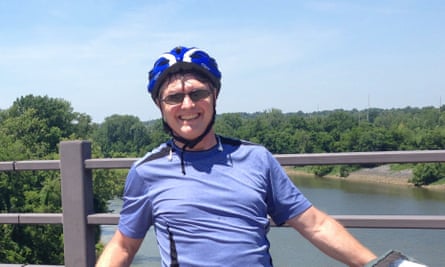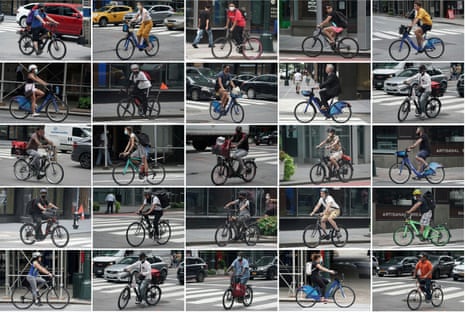The number of people who ride their bikes to work in the US has been steadily falling over the past few years, even before the pandemic, according to data collected by nonprofit League of American Bicyclists. In 2014, about 900,000 people rode their bikes to work but in 2020, just over 783,000 did – about 0.5% of all workers.
Meanwhile, the number of bicyclists killed in the US continues to rise, from 723 in 2014, to 938 in 2020.
In response to a Guardian callout, US-based readers spoke of quitting cycling for various reasons. Some said that they got off the road because of age, and others because of health restrictions. But the main concern for the overwhelming majority was road safety; many had either personally been hit by a motorist or had seen too many reports of bicyclists getting struck by motorists to want to keep cycling.
However, the reason behind this concern for road safety from those who got in touch differed; some described an influx of distracted driving – drivers on cell phones – as well as blocked bike lanes from double-parked delivery vehicles and users of motorized scooters now sharing the lanes. Meanwhile, others talked about motorists harassing cyclists, aggressive drivers, roads not designed for bicyclists and an increase in bicycling traffic adding to the dangers they faced. Some readers noted a lack of respect that motorists seemed to have for cyclists, whether in the form of road rage – or worse.
Here, readers from around the US explain why they have given up riding their bikes on the road.
‘What used to be fun has become fearful’
The density of double-parked delivery vehicles in dedicated bike lanes and increased traffic on Brooklyn’s streets have made cycling dangerous. I used to enjoy going from Bay Ridge in Brooklyn to Riis Park in Queens, but many drivers are distracted by their cell phones and frequently do not observe stop signs or engage in defensive driving. What used to be fun has become fearful. Bruce W Rerek, 65, retired caterer; Brooklyn New York
‘The increase in bicycle traffic has itself created hazards’
After moving to Berkeley, California in 1992, I soon realised that the roads in the East Bay had outgrown their designed motor vehicle capacity 30 years prior and were never designed for bicycle traffic. I have lived in the Berkeley Hills for nearly 30 years. Regularly bicycling to or from anywhere that is hilly for any reason is not practical. This is not the Netherlands. I soon stopped bicycling on a regular basis because of hilly terrain, increased traffic, poor road surface condition and general issues of safety.
Since then, the increase in bicycle traffic has itself created hazards. There are more bicyclists, the overwhelming majority of whom have no idea how to properly operate a bicycle as a vehicle in traffic. That there are not just painted bicycle lanes, but physically separated bicycle lanes on what once were motor vehicle roads is evidence supporting that view. On more than one occasion I have encountered a bicycle proceeding against the flow of traffic on a three-lane roadway with no shoulder on either side. It has become almost cliche, but it is in my experience that inexperienced bicyclists behave as if stop signs do not apply to them. As a result, drivers have become overly cautious in the presence of bicycles, relinquishing their right of way to a bicycle in what has become a distracting road hazard. Michael, 79, retiree; Berkeley, California.
‘Several bad crashes over the years and too many close calls’
Two years ago I crashed head-on into an inattentive cyclist on a bike path. They were riding next to their friend, chatting, making eyes with one another. They drifted into me at the last moment. It was the height of the pandemic – they had no masks, no helmets. I was badly injured and will never be the same. This was the last straw for me. I have had several bad crashes over the years and too many close calls with motorized traffic to count. Some of these encounters were with drivers who saw me and threatened me with their vehicles, some with drivers who failed to see me. Ask any urban cyclist – such encounters are routine. Ray Hogan, 72, retired nurse; Portland, Oregon
‘It just feels too dangerous’
Traffic has increased rapidly over the last three to four years. While we have marked bike lanes, they are not separated from the street by barriers. People are driving fast both on city streets and freeways, running stop signs and driving aggressively. There is little traffic law enforcement on city streets. It just feels too dangerous. Ruth Meacham, 76, retired teacher; Bellingham, Washington
‘The streets of New York are crazier than ever’
I lived in New York for most of my 20s and biked frequently. I left around 2012 and came back in 2021. My partner and I brought our nice new bikes with us, but they’ve mostly sat in our apartment for the last year, save a ride or two. The reason? Despite the addition of new (suggested) bike lanes, the streets of New York are crazier than ever. The bike lanes are full of motorized scooters, bikes, dirt bikes and motorcycles. Even most bicycles are electric-powered now and much faster than my manual bike. On top of that, motorists and scooter drivers are more distracted than they were 10 years ago, and obeying the rules of the road has apparently gone out the window. I feel less safe as a pedestrian. Using my bike just feels too risky now. Noel Benford, 39, studying software development; Astoria, Queens
‘There is too much road rage’
I’ve never owned a car and spent my adult life riding a bike. I raised my son, who is now 22, on a bike. After hundreds of thousands of miles, I was hit for the first time from behind in 2015. I was so fit and strong that I only suffered soft tissue damage when I rolled onto the grassy shoulder, but in 2017, I was hit for the second time and I broke my right leg so badly I needed a bone marrow transplant. Even after that, I started taking my folding bike out on the road with me in my truck just to ride around different places, but it is too dangerous and there is too much road rage. People who are willing to try and drive aggressively with an 80,000-pound semi truck will think nothing of running over a human being on a bicycle just because they think they are in the way and a nuisance. Gretchen Elsner, 42, long-haul truck driver; Athens, Georgia,
‘There are very few dedicated bike lanes’
I have been a bicyclist my entire life. I cycled in college, and on vacation. I started cycling again regularly just as the pandemic started. I have biked almost every day since March 2020, but I stopped biking to my gym about a month ago. It’s dangerous to bike around here because there are very few dedicated bike lanes. We do have very nice bike trails within the parks and the woods, but it is dangerous when a bicyclist has to travel near major roads. The sidewalks are extremely close to the roads where cars travel at high speeds in a culture that seems hurried and gravitates around the phone. There have been many, many accidents just in the past year where drivers have hit and killed children at bus stops, bicyclists on sidewalks, and most recently, a young mother of two who was cycling in plain daylight in a dedicated bike lane in Bethesda. She survived many dangerous war zones as a state department employee, only to be killed by a moving truck in a dedicated bike lane in the US. Not long before that, another young state department employee was killed in a Washington DC street, again where she was hit by a truck. These two young women were in their early 40s, the same age as my own children, so these accidents really left an impact on me.
My gym is on a major six-lane road in Bethesda. In 2019, a 17-year-old bicyclist was killed after he swerved to go around some obstructions on the sidewalk and was hit by a car. After this, officials added dedicated bike lanes to the road, but the lanes did not have any barriers, so a driver who wasn’t paying attention could easily drift into these lanes. It was an improvement, but the lanes only went for a block or two on this major road. It gave bicyclists a false sense of security. In June of this year, as I was driving back from the gym in the early afternoon, there was a big traffic backup. I later learned that an 18-year-old bicyclist was hit by a car and died. He was on a stretch of the road where there were no dedicated bike lanes. Fran, 69, computer analyst; Bethesda, Maryland
‘It’s simply not worth the risk’

I’ve completed several long tours, up to three months on the road. I love moving through the countryside, absorbing the scenery and culture as I travel. But these days I mostly ride indoors on my Peloton. The roads today – even in a car – are just too dangerous. Folks drive too fast. They have forgotten basic civility and they are too distracted by their mobile devices. I used to ride the Natchez Trace Parkway, near Nashville. The posted speed is 50 miles per hour, with wide lanes. You’d think it would be a place where cars and bikes could travel in harmony. Well, I stopped riding there after I watched a GoPro video of a bicyclist being deliberately run over. I sure do miss the freedom of the road, but these days, it’s simply not worth the risk. Mike Wurst, 60, works in healthcare IT; Nashville, Tennessee
